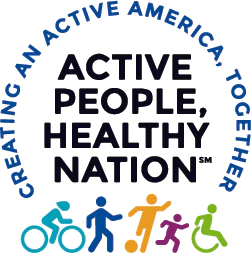BUILDING HEALTHY MILITARY COMMUNITIES TOOLKIT
A RESOURCE FOR THE DEPARTMENT OF DEFENSE HEALTH PROVIDERS AND COMMUNITIES
Physical Activity Policies

Active People, Healthy Nation℠ is a national initiative led by CDC to help 27 million Americans become more physically active by 2027. Increased physical activity can improve health, quality of life, and reduce health care costs. These improvements can help reduce the risk of at least 20 chronic diseases and conditions and provide effective treatment for many of these conditions. Other potential benefits include better school performance and improved military readiness. Building active and walkable communities can help support local economies, result in less air pollution, and create more cohesive communities.
CDC has collected multiple science-based strategies to increase physical activity. You can learn more about them through the topic buttons on this page.
What you can do:
- Conduct a walk audit where a high proportion of Service members live. Suggest places for improvement to the local public works, transportation department, or elected officials.
- Engage Service members and their families to share their vision of what the built environment should look like to promote physical activity or what issues they would like to see addressed.
- Refer Service members’ to Safe Routes to Schools programs or encourage them to create one in their neighborhood if there is not already one.
- Promote social support interventions such as walking or cycling groups that create or strengthen social networks that help people increase their physical activity.
- Ask SHIP/CHIP planning committees to add built environment work to their improvement plans. They will need to collaborate with community members, city planners, parks and recreation, public works departments, traffic engineers, and others to:
- Adopt Complete Streets policies for safe and convenient access to community destinations.
- Create bicycle or pedestrian master plans to make bicycling, walking, wheelchair rolling, and riding transit safer, more convenient, and more realistic travel options.
- Encourage built environment approaches that combine one or more interventions to improve transportation systems (activity-friendly routes) with one or more land use and community design interventions (everyday destinations) to increase opportunities for active transportation and/or leisure time physical activity.
- Adopt zoning code reforms that promote physical activity.
- Develop shared/joint agreements that allow community members to use existing community facilities such as playgrounds, gyms, or pools.
- Help the family members of Service personnel understand the benefits of physical activity and how much physical activity is needed for each age group.
- Encourage Service members to:
- Sign up to be a part of Active People Healthy Nation℠
- Share their physical activity successes on social media using #ActivePeople and take advantage of CDC’s sample social media posts.
- Connect with other members of Active People by using #ActivePeople on social media.
- Download an Active People Badge or add an #ActivePeople frame to their Facebook Profile.
- Start being more physically active today.
- Share the educational materials offered on the Move Your Way website with Service members’ families to learn how they can become more physically active.
- Use and share the Active People, Healthy Nation resources in newsletters and daily social media posts.
Disclaimer: Active People, Healthy Nation is an HHS service mark. Use of Active People, Healthy NationSM does not imply review, approval, or endorsement by HHS.
